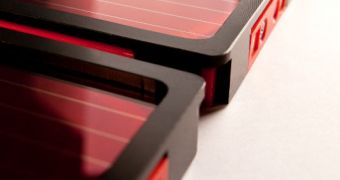A collaboration of Belgian researchers, featuring members from the imec research center, Plextronics and Solvay, recently announced the development of a new type of organic solar cell. The device is more efficient than similar cells developed in the past, and has numerous applications.
The organic, polymer-based, single-junction solar cell displays a 6.9 percent performance level. It is constructed in an inverted device stack that the collaboration developed specifically for this tool.
Module level efficiencies for the integrated polymer cells reached as much as 5 percent, for a total aperture area of around 25 square centimeters. These capabilities open up new practical applications for the device, including the development of high-efficiency solar cells for industrial customers.
Within two to three years, imec expects to improve the conversion efficiencies of its solar cells to no less than 10 percent. The company will also work to improve the practical lifetime for its devices, aiming for at least 10 years of guaranteed service.
“We are delighted to present these excellent results, achieved by combining imec’s expertise and knowhow in organic photovoltaics R&D with Plextronics’ innovative material,” says the team leader for Organic Photovoltaics R&D at imec, Tom Aernouts.
“With further optimizations to the material as well as to the architecture, for example by introducing a multi-junction featuring different layers of different polymers each capturing another part of the light spectrum, we envision organic solar cell […] aiming at industry-relevant solutions,” he adds.
The new design, which uses imec’s scalable inverted device architecture and Plextronics’ polymers, was presented this week at the European Photovoltaic Solar Energy Conference and Exhibition (PVSEC). The meeting is held in Hamburg, Germany.
The reason why organic solar cells are so important is because they provide low-cost, thin-film-based alternatives to the tremendously expensive silicon photovoltaic technology currently being used.
“Partnering with industry leaders like imec and Solvay allows us the opportunity to explore new approaches to accelerate the performance of OPV technology incorporating our proprietary polymers,” says Andy Hannah, who is the president and CEO of Plextronics.
“We believe organic photovoltaics will play a bigger role in the future, when we can boost efficiency and lifetime, at a reduced cost price,” concludes the Sustainable Energy Platform manager for Solvay's Innovation Center, Patrick Francoisse.

 14 DAY TRIAL //
14 DAY TRIAL //